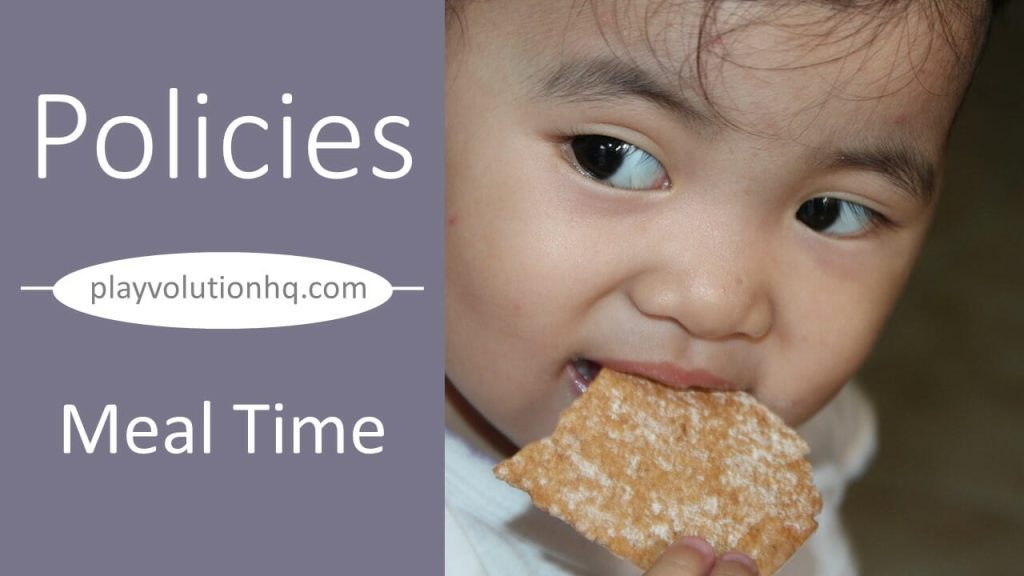
Meal Times Overview
This post covers the logistics of meal times for students who are beginning to eat, or currently eating, solid foods (that is, not infants.) If you’re looking for more about crafting nutrition guidelines for foods brought from home, see here. If you’re looking for more about nutrition guidelines for foods prepared and served by your program/center, see here.
This post is intended to spark reflection and suggest ways of addressing the topic covered when writing or updating policies and procedures. Your policies and procedures should be written to meet your program’s needs and unique circumstances.
Browse More Policy & Procedure Resources Here
Children need to eat. With a variety of outside-of-school schedules – some students spending more time at home, some going to before-or after-school activities, some students eating many small meals throughout the day and others only eating when they’re in your program – it can be a challenge to create a respectful, workable mealtime schedule.
The first thing to consider when deciding meal times are the requirements of your local licensing agency. Some states/regions have policies specifically related to meal times that depend on the length of the program day, the ages of the children enrolled, and how much time passes between meals. A very basic framework for scheduling meal times for toddlers and young preschoolers would be offering food every two and a half to three hours; for older children, every three to four. Again, check with your local licensing agency to ensure your chosen schedule would be in compliance.
Generally, family-style meal times are encouraged for most early childhood settings. This typically includes a specific time for a meal, where children help set the table, sit together with the caregivers (who also eat the meal), and pass food to serve themselves, receiving assistance as needed. Children are considered active participants throughout the process. A few resources about family style meals are as follows:
Some programs/centers encourage caregivers to include children in snack cooking or preparation, while some states/regions discourage children from touching food that will be served to anyone but themselves. In these cases, food might be pre-portioned into cups or bowls by adults and then taken by children. Some children might not eat ‘family style’ meals at home and might need extra guidance on how to participate in the meal.
Children that bring food from home can still eat in a modified family style setting, although systems for gathering lunchboxes, opening food, and clean-up will need to be practiced and modified as appropriate. Some programs serve larger meals (like breakfast or lunch) as family style and smaller meals/snacks in a more free-range/open table way, where students can join and eat as they please.
Consider guidelines for children that do (or do not) want to eat at certain times – will they be allowed to get their snacks whenever they’re hungry? Will be allowed to get snacks only within a certain window? Where are they allowed to eat or not eat? Will these policies be up to individual caregivers, or set for the entire center/program?
Where To Include
At Playvolution HQ, we recommend using the Three Handbook Method.
Consider adding this policy to your Operating Handbook.
Considerations
- Make sure you (and your staff) know and understand your licensing agency’s food handling requirements.
- Some students might need more frequent (or less frequent) meal times due to health reasons.
- Withholding food from a child or forcing a child to eat constitutes child abuse.
- Children eat at different speeds – consider expectations for children that finish eating early or eat slower. What will they do, and who will set the expectation (individual classrooms or the whole school?)
- Reusable tableware is more environmentally friendly (and can be more economical in the long run) but requires consistent upkeep and care (that could come with additional regulations and cost). Disposable tableware is easy to clean up, but generally more wasteful.
- Not all food will be eaten, so a plan for saving or disposing of food (consider composting, if it’s available in your area) should be clear.
Sample Policies
NOTE: The following samples are real-world examples relating to this post’s topic and are provided as a reference for creating your own policies and procedures. Sharing them here is not a recommendation of their content.
Sample 1
Snacks at SYC
Snack time is a very social time. Children like to sit, eat and talk, so we provide an open snack at the snack table during playtime. This is made possible by asking parents to take turns bringing in the open snack, following [our] guidelines.
While snack is a social time, it’s also a chance for children to learn to make food choices: am I hungry, what am I hungry for, what can/should I eat, how much will I eat. We know that some children have allergies, some have sensitivities, and some children/families have dietary preferences and may not be able to eat all foods. The preschool years are a good time for children to begin making these decisions with the guidance of their parents and teachers.
For this reason, while we will not allow an open snack that will cause an anaphylactic reaction, there may be foods offered that your child may not eat because of a sensitivity or a personal/family preference.
Open Snack is food available to everyone during playtime and Sit-Down Snack is a group activity where everyone sits down together and each child eats the food he/she brought from home that day. In an instance in which snack is forgotten or we run out, SYC will supplement, typically with a cereal grain and a canned fruit. This stock is checked and replaced on a bi-weekly basis.
School for Young Children, Ohio, USA
Sample 2
Nutrition
The center serves breakfast, lunch, and an afternoon snack. All meals and snacks meet the nutritional requirements of the California Child and Adult Food Program. Children are encouraged to try new foods, to measure, cut, mix and follow simple recipes.
Please let us know of any food allergies your child may have or if you have any special dietary requests required for health or religious reasons. A child must have a doctor’s note in order to be offered a substitute for cow’s milk. Infants and toddlers will have individualized feeding plans. We utilize family style eating which means children sit down with teachers while eating, engage in conversation, and serve their own food.
Grossmont College Child Development Center, California, USA
Related Content


Brought to you by Explorations Early Learning
Contribute content to Playvolution HQ
Author
Student, teacher.
In-Person And Online Training
Learn how to book an in-person or online training for your organization on these early learning topics.
Support The Site
I participate in the Amazon Services LLC Associates Program, an affiliate advertising program designed to provide a means for me to earn fees
by linking to Amazon.com and affiliate sites.
Thanks To Our Patrons
This post was made possible by patrons like these, who generously fund our work:
Supporters
Lissadell Greene Stephanie Goloway Jennifer Stark
Lagina Kozak Michelle Hankins
Marie Messinger Tamara L. Lakin
Fans
Jen Flemming Lizz Nolasco Cynthia J Bays
Susan Warner Kelly Sigalove Shawn Wolf
Vittoria Jimerson Codee Gilbert Wendy Tedford
Monica Morrell Pam Soloman Melissa Franklin
Teresa Watson Erika Felt Autumn Peele
Melissa Taylor Jahmeela Robinson Stacie Manning
Amber Maurina Terra Calamari Anne Jackson
Lagina Kozak Samantha Yeager-Cheevers
Elizebeth McCoy Sammy Cousens Ellen Cogan


Leave a Reply